Baguio, often called the “Summer Capital of the Philippines,” is known for its cool climate, scenic mountain views, and rich history. Yet, one of its most enticing aspects is its culinary scene, which boasts a tapestry of flavors influenced by the city’s diverse communities and the indigenous people of the Cordillera region.
For food enthusiasts, travelers, and anyone with an appetite for adventure, this guide delves deep into the local dishes and delicacies that make Baguio an essential stop for any culinary journey through the Philippines.
Local Dishes of Baguio
Peering into Baguio’s gastronomic history, you’ll find a collection of dishes that define the city’s unique character. Here are some must-try local favorites.
Strawberry Sinigang
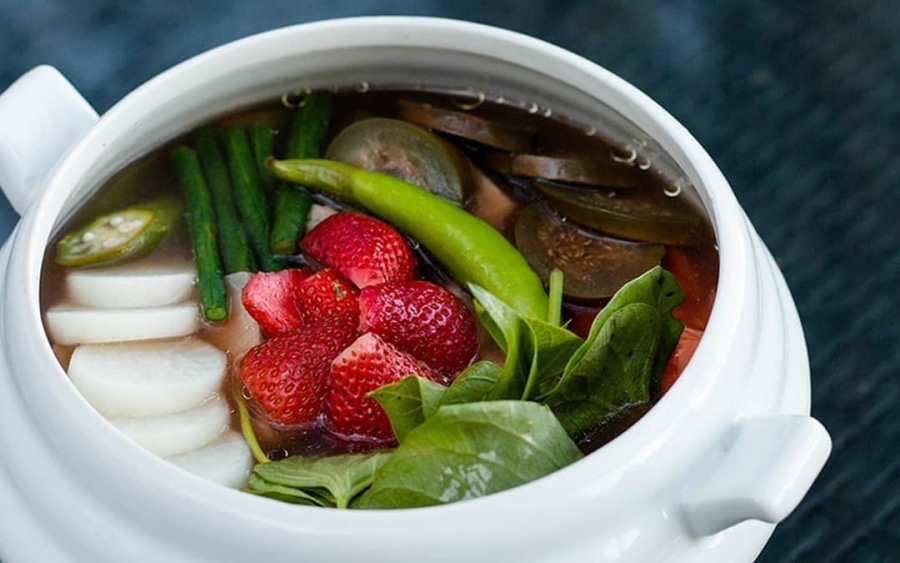
Alt-text: strawberry sinigang | Photo via Mines View Park Hotel
Strawberry Sinigang, a playful twist on the classic Filipino sour soup, incorporates Baguio’s most famous fruit to give it a sweet and tart balance. This dish celebrates the region’s bountiful strawberry fields, combined with the piquant flavors of tamarind, tomatoes, and various meats (commonly pork or shrimp). It’s a delightful contrast of flavors that reflects the innovation of local chefs in integrating unique ingredients into familiar dishes.
Binungor
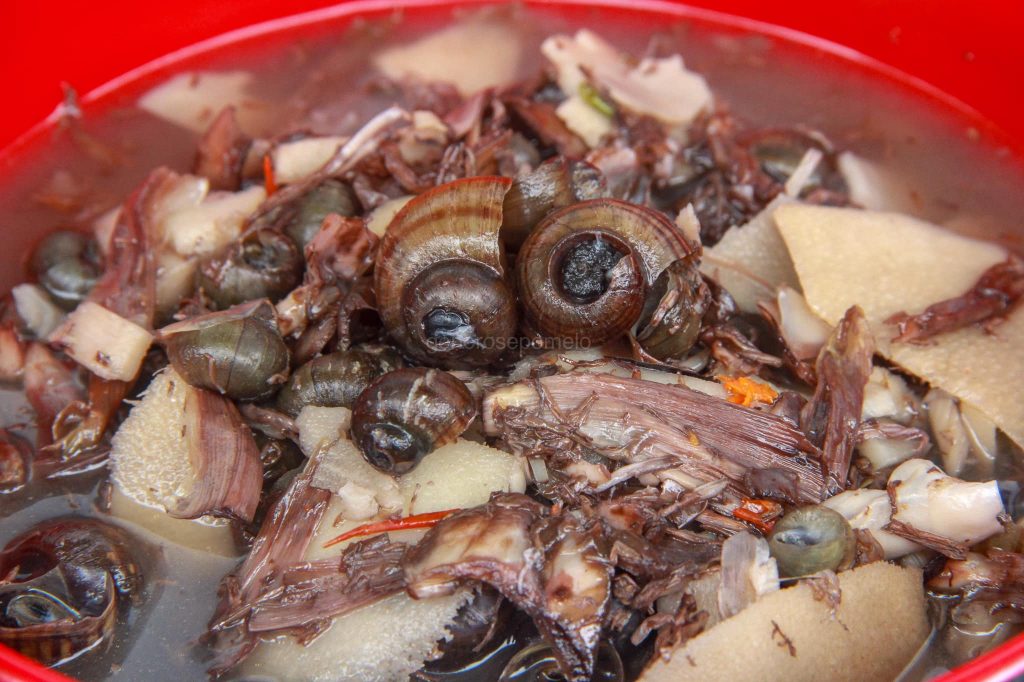
Alt-text: binungor | Photo via generospomelo
Binungor is a traditional dish from the Cordillera region, specifically known for its preparation by Kalinga farmers. It features agurong and bissukol (stir-fried water shells) mixed with rabong (bamboo shoots), local mushrooms, langka (jackfruit), and chili pepper. The dish is cooked in pork fat and served with a generous amount of onions, garlic, and tomatoes. Binungor is a unique combination of flavors, with the pork fat’s richness balancing out the chili pepper’s spiciness and the vegetables’ earthy flavors.
Pinikpikan
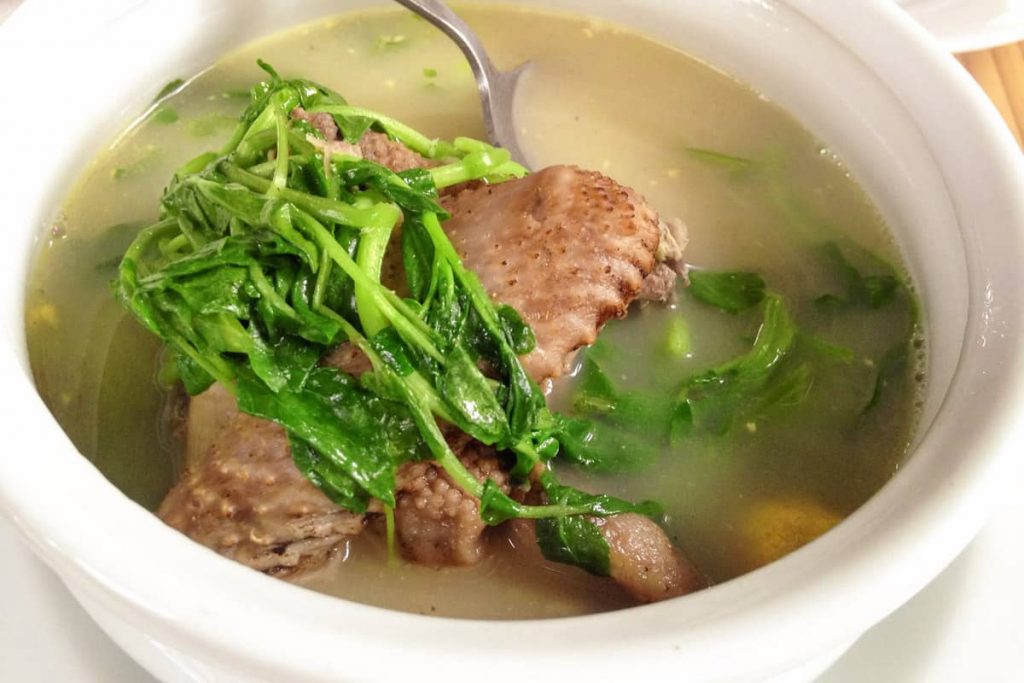
Alt-text: Pinikpikan | Photo via thepoortraveler
Pinikpikan is a ceremonial dish from the Cordillera region, particularly shared during rituals in the indigenous communities. It involves beating a live chicken with a stick before it is cooked, which is said to impart a distinct flavor. The raising and meeting of the chicken’s meat are sacred and symbolic, today’s Pinikpikan in Baguio is typically prepared using organic chicken, with the ceremonial aspect being honored in more subtle ways in line with modern practices.
Pinuneg
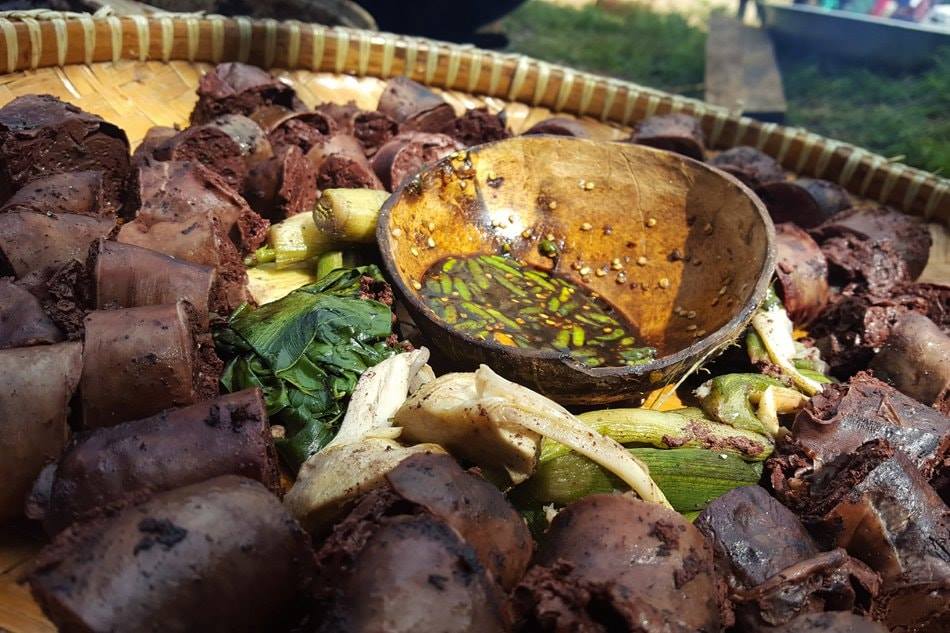
Alt-text: Pinuneg | Photo via The Igorot Facebook Page
Pinuneg, or Filipino blood sausage, is a local breakfast staple showcasing the Cordilleran preference for using all animal parts. It consists of a mixture of pig’s blood, innards, and rice stuffed in a casing, typically made of the pig’s intestine. These are fried to perfection, offering a savory and slightly iron-rich taste that’s beloved by locals and adventurous eaters alike.
Kiniing and Etag

Alt-text: Kiniing And Etag | Photo via Jilson Tiu
Kiniing and Etag both refer to the traditional method of smoking meat, particularly pork. These are offerings found not only in Baguio’s local restaurants and eateries but also in its bustling markets and streets. Kiniing and Etag are often enjoyed as mains or flavor-packed additions to popular dishes, bringing a strong, smoky taste that lingers in the memory of those who experience them.
Kiniwar
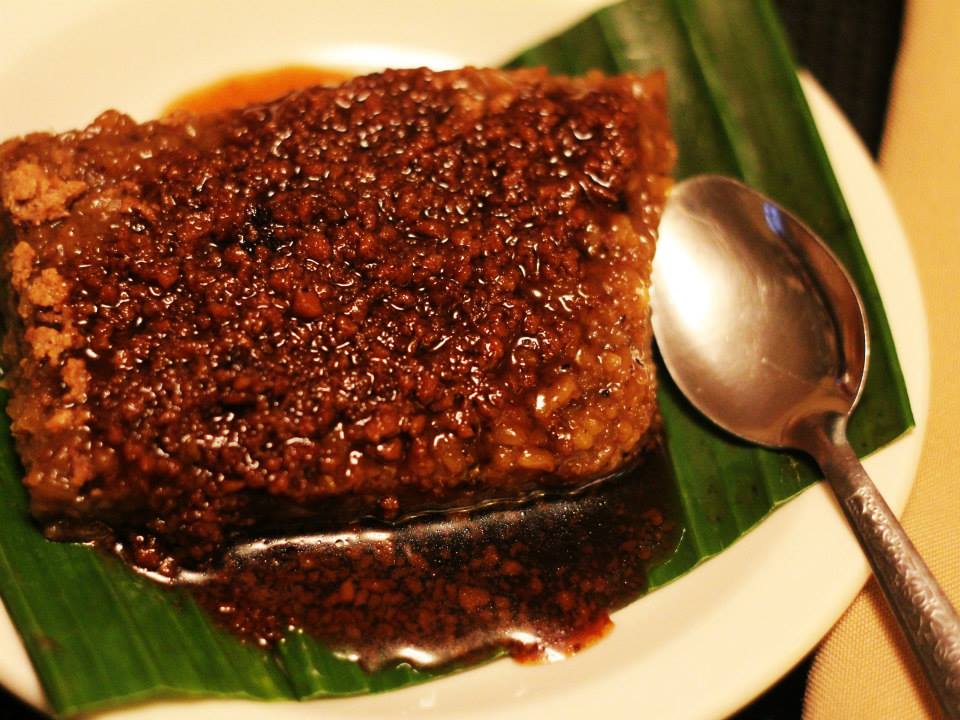
Alt-text: Kiniwar | Photo via Yagam Coffee
Kiniwar, much like biko, is a glutinous rice-based dish made using coconut milk, sugar, and various flavorings. What sets it apart from other rice cakes is its smoky taste, achieved through the use of burnt coconut husks during cooking. Kiniwar is a staple of local celebrations and festivals, but it can also be found in many dining establishments around Baguio.
Strawberry Shortcake

Alt-text: Strawberry Shortcake | Photo via Booky
Last but not least, Baguio delights with its Strawberry Shortcake, a sweet ending to an exploration of the city’s culinary landscape. Layered with fresh strawberries, this cake is a perfect expression of Baguio’s famous fruit, showcasing the region’s love for sweet treats and the annual Strawberry Festival that draws in crowds every March.
Delicacies You Should Try
In addition to its unique dishes, Baguio is a treasure trove of local delicacies that stand out for their quality and distinctiveness. These are the items you definitely shouldn’t miss.
Ube Jam
Baguio is known for its delicious Ube Jam, a sweet spread made from purple yams. This vibrant, sweet treat is a favorite for both locals and tourists, highlighting the Philippines’ love for ube in desserts and pastries. Don’t leave Baguio without purchasing a jar (or two) of this sweet and velvety jam.
Sundo’t Kulangot
While its name may raise eyebrows, Sundo’t Kulangot is actually a delightful snack made from sticky rice mixed with coconut milk and sugar, which is then wrapped in banana leaves and steamed to perfection. It has a delectably gummy texture and a coconut-infused sweetness that make it a must-try for those with a sweet tooth.
Peanut Brittle
Baguio’s Peanut Brittle, or “Kaysa” in the local dialect, is a crunchy, nutty confection that’s a popular purchase among visitors. Made with Baguio’s finest peanuts and caramelized sugar, this treat offers a satisfying crunch and locally sourced ingredients’ sweet, earthy taste.
Strawberry Wine and Craft Beer
Crafted with care and expertise, Baguio’s wineries and breweries produce some of the finest beverages in the country. Baguio is renowned for its quality strawberry wine, made from locally grown berries, and an array of craft beers that cater to all beer aficionados. A sip of these beverages offers a refreshing experience and a glimpse into the city’s rich agricultural landscape.
Where to Find Them
To truly experience the depth of Baguio’s culinary scene, one must wander into the city’s eateries, markets, and food stalls. Here are some of the top spots to indulge in Baguio’s local food offerings.
Top Eateries, Markets, and Food Stalls in Baguio
- Good Taste Restaurant & Food Center: A local favorite that serves an extensive menu of Filipino and Chinese cuisine, Good Taste boasts hearty servings that satisfy both the budget-conscious and the hungry.
- Baguio Public Market: This bustling market is a treasure trove of fresh produce, specialty food items, and local crafts. It’s the perfect place to sample and purchase Baguio’s unique offerings straight from the source.
- Ililikha Artist’s Watering Hole: A social enterprise that showcases the works of local artists and offers a menu of home-cooked Filipino dishes, Ililikha is a must-visit for those who want to support the city’s creative community while enjoying delicious food.
- Session Road: Every Sunday, Session Road is closed to traffic and transformed into a bustling food market. Here, you can sample various local dishes, street food, and delicacies while enjoying live music and entertainment.
- Night Market at Harrison Road: This nightly bazaar offers a variety of local street food, including Baguio’s famous strawberry taho (sweetened tofu), along with bargain items such as clothes, accessories, and souvenirs.
Tips for Food Enthusiasts and Travelers
When embarking on a culinary exploration of Baguio, it’s important to remember some dos and don’ts to make the most of your experience.
Dos and Don’ts When Exploring Baguio’s Food Scene
Do:
- Try local street food for an authentic taste of Baguio.
- Ask the locals for their favorite food recommendations—they often lead you to hidden gems.
- Be adventurous and open-minded, as some local delicacies might not sound familiar but can be surprisingly delicious.
Don’t:
- Assume that all dishes contain ingredients you’re familiar with. Always ask what’s in your food.
- Discount the small food vendors or stalls on the streets—they are often the ones with the best, most traditional recipes.
- Be afraid to haggle at the markets, especially when purchasing various snack items and souvenirs.
Venture on a Culinary Journey With El Retiro
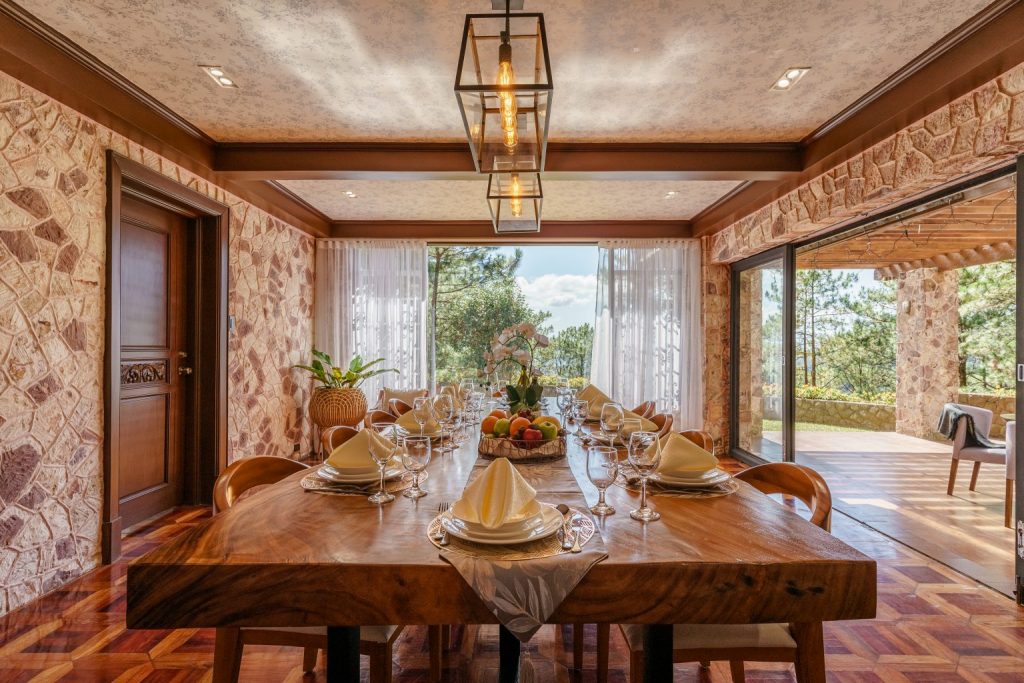
Embarking on a journey to savor the flavors of Baguio is more than a culinary delight—it’s a rich tapestry of culture, history, and community. The city’s local dishes and delicacies, renowned for their unique components and combinations, showcase the heart and soul of the Philippines’ artistic heritage.
To truly understand and appreciate a destination, one must stay in a place that embodies its essence. El Retiro offers an experience that goes beyond comfortable accommodations and excellent service—it’s a gateway to Baguio’s cultural and culinary soul.
With our personalized services, our warm and friendly staff can assist you as you embark on a one-of-a-kind gastronomic adventure. We can help you plan an intimate event for your group while you enjoy the beautiful scenery and luscious pine forest as your backdrop.
Contact us to learn more about our amenities and services and how we can make your stay in Baguio memorable.
